This blog post covers which strategy truly converts better, and when, and why the answer isn’t as simple as it seems.

The moment your customer reaches the checkout, your shipping policy becomes a decisive factor in whether they buy or bounce.
This blog post covers which strategy truly converts better, why the answer isn’t as simple as it seems, and how top-performing businesses are using shipping psychology to maximize margin and conversion.
Why Free Shipping Is Not Always The Holy Grail
Free shipping dominates consumer expectations, especially Gen Z's expectations. Market research shows that more than 70% of U.S. consumers consider free shipping more important than fast shipping. Large platforms like Amazon have normalized “free” as the default, making any costs for shipping feel disappointing and frustrating.
But here’s the problem: free shipping isn’t free for you. Every “free” delivery costs somewhere between $6–$12 on average for standard packages in the U.S., depending on weight, distance, and carrier. If you’re not recovering this cost through higher prices of the products, increased order values, or better retention, you’re losing margin.
Some ecommerce merchants try to absorb the cost directly. Others build it into the product price. But too often, the decision is made without any modeling of unit economics or CPA (cost per acquisition) blended with logistics spend. That’s where trouble starts.
Conversion may rise, but so do return rates. Shoppers tend to treat free-shipping items as low-commitment purchases, and to be honest, I've done this too as a customer. Hundreds of times, especially with clothes. As far as I can get (and often return) something for free, I don't think much about purchasing it. And on the contrary, if the shipping costs me money, I spend more time evaluating if I really need this product.
Flat Rate: Predictability With a Catch
Flat rate shipping offers simplicity: customers know what to expect, and businesses can maintain tighter control over margins. This works particularly well when your product line has uniform dimensions and your fulfillment costs are consistent across zones.
However, flat rate shipping doesn’t spark the same psychological urgency or satisfaction as “free.” While it can reduce friction caused by variable or calculated shipping rates, it rarely increases conversion on its own. In fact, flat rate shipping often needs to be justified contextually through product value, fast delivery, or brand experience.
One underrated benefit of flat rate shipping is operational: it allows for easier batching, zone-based delivery forecasting, and cleaner invoicing, which is particularly useful if your customers include B2B buyers or high-repeat consumers.
What the Data Actually Shows
In controlled A/B tests conducted by ecommerce platforms like Shopify Plus and segmented campaigns tracked through platforms like Privy and Klaviyo, a few trends emerge:
- Free shipping without thresholds boosts conversion the most but often at the cost of average order value (AOV) and margin.
- Free shipping with a minimum order threshold tends to offer the best balance between conversion and profitability.
- Flat rate shipping performs best when paired with high-ticket items or bulky goods, where “free” isn’t credible or sustainable.
For example, a store offering free shipping over $50 saw a 14% lift in AOV and a 10% increase in conversion. In contrast, the same store offering free shipping with no minimum saw an 18% conversion increase, but AOV dropped by 6%, significantly hurting net profit per order.
The implication is clear: free shipping works best when it incentivizes higher spend, not when it’s simply handed out.
Hidden Metrics That Tell the Real Story
Too often, ecommerce operators track only surface metrics (conversion rate and AOV) when evaluating shipping strategies. But there are more telling numbers that should drive your decision:
- Contribution margin after fulfillment: Knowing your profit per order after accounting for the full cost of shipping, packaging, and handling is critical. Many “profitable” orders lose money once fulfillment is factored in.
- Return rate variance by shipping type: Free shipping often correlates with higher return rates, especially for apparel or high-variation products. A study by Narvar found that return rates were 20% higher on average for items with free shipping vs. flat rate.
- Customer lifetime value (CLV) uplift: Free shipping is often more justifiable when viewed through a CLV lens. If it brings in more repeat buyers, your ROI improves dramatically, even if the first sale is barely profitable.
- Delivery reliability and experience: Flat rate allows for more flexibility in choosing higher-quality or faster services without communicating variable pricing to customers. That can reduce failed deliveries, which silently eat into profits.
Real Strategy: Don’t Pick One But Combine
The best-performing ecommerce merchants rarely choose just one shipping strategy. Instead, they blend them depending on context, product type, and customer segment.
For example:
- Offer free shipping over a threshold (e.g. $50 or $75) to increase AOV. This works especially well when paired with product recommendations or bundles.
- Use flat rate shipping for items that are either high-margin or large/difficult to ship, like furniture, home goods, or oversized apparel.
- Introduce VIP tiers or segmented free shipping offers for loyal customers, newsletter subscribers, or repeat buyers.
- In high-cost shipping zones (e.g. Alaska, Hawaii, rural areas), offer zone-specific flat rates to avoid margin erosion while keeping expectations clear.
Final Thoughts
Free shipping can be a powerful conversion tool—but it’s only effective when backed by strategy, not guesswork. Flat rate shipping can protect your margins, but only if it doesn’t create friction in the buying journey. The right approach should balance conversion, profitability, and brand trust.
If you're starting or scaling your ecommerce store, take time to model your shipping costs by zone, product, and average cart. Then test. Use A/B experiments on your product pages and checkout flows.
Ultimately, the best shipping strategy is the one that encourages conversions and sustains your margins.
Never miss a post
You may also like…
You too can reduce costs and improve efficiency with Ufleet
- plan and optimize delivery routes
- manage and empower drivers
- enhance customer experience
- make data-driven business decisions
We’d love to learn about your challenges.
Leave your email and we’ll get back to you.





